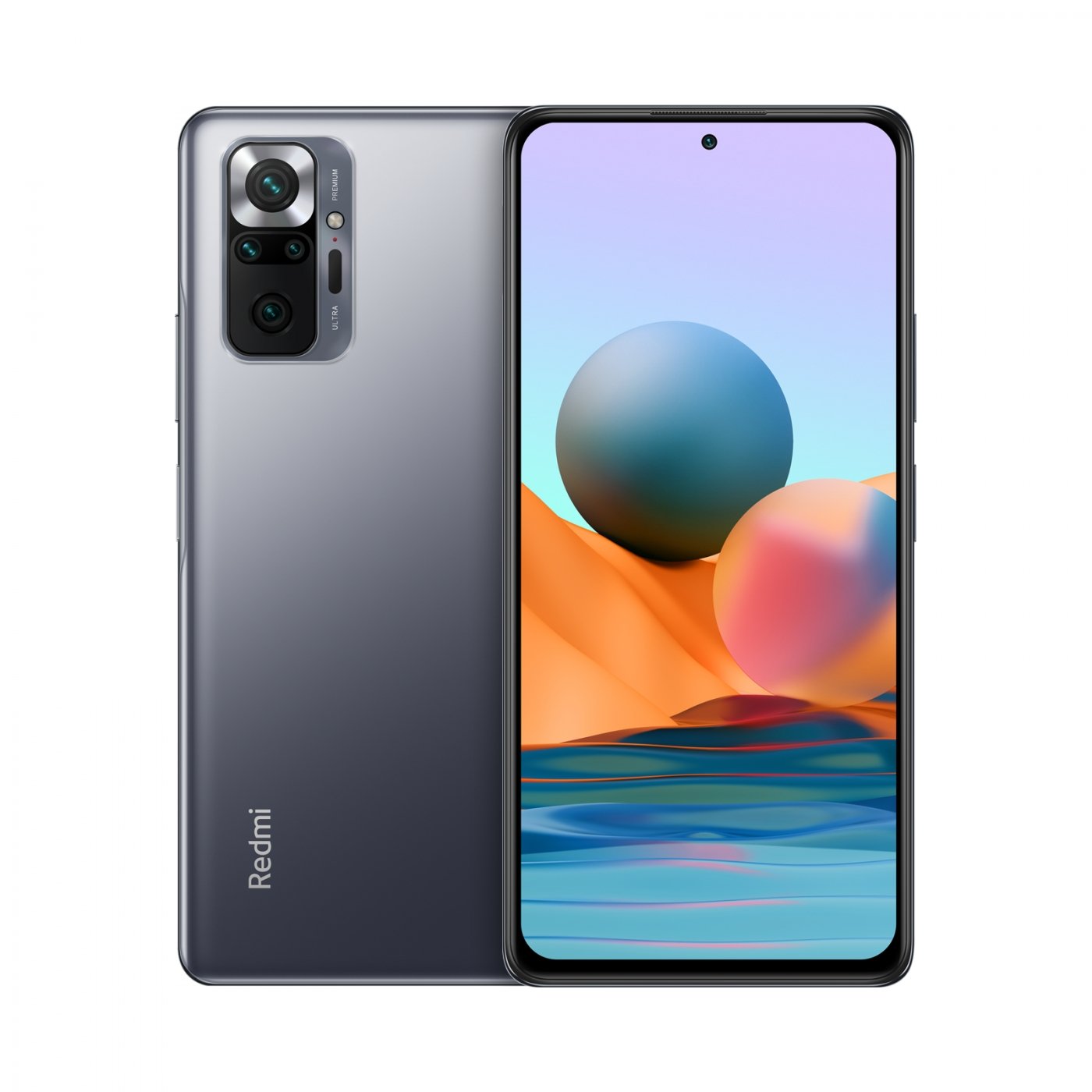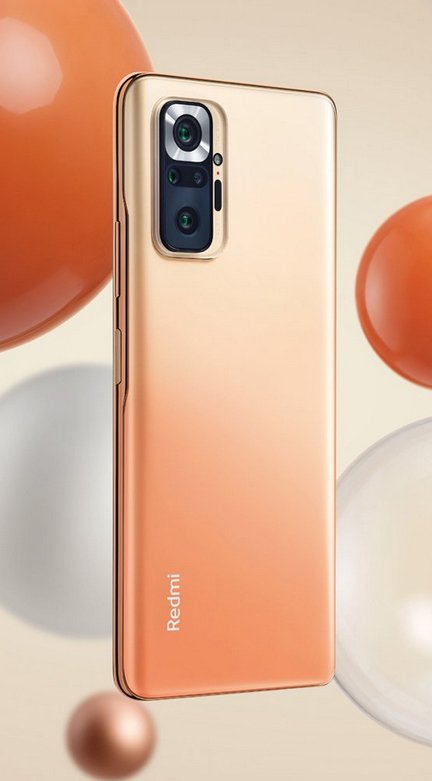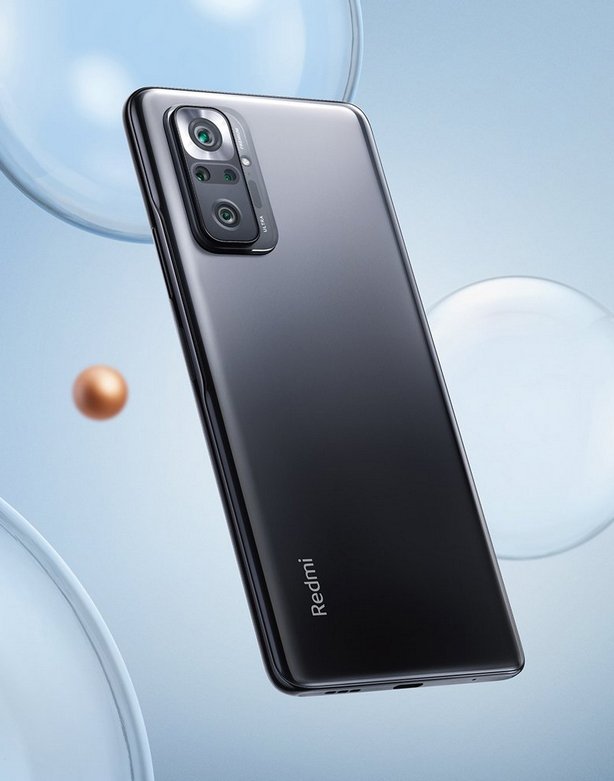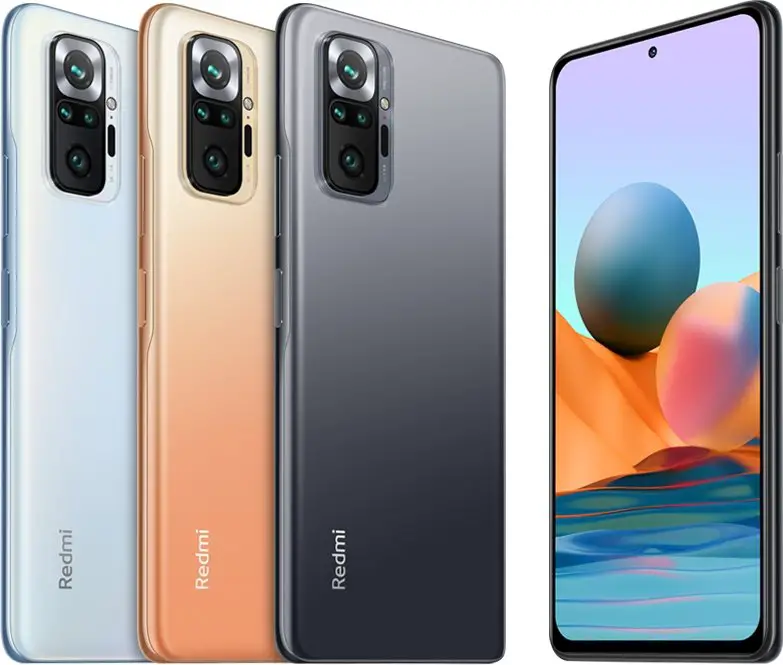This is the Xiaomi Redmi Note 10 Pro, which is one of the best budget phones for 2021. Its base price is around $300 and for the money you get a large AMOLED display with a refresh rate of 120Hz, Snapdragon 732G chipset, large 5020 battery mAh, quad camera with 108 MP, support for 2 SIM cards, Micro SD card, dual speakers, headphone jack and infrared port. There are also some features that typical for the flagships but are missing here as 5G, WiFi 6, water resistance IP 68 and a high-end processor. But these specs are very good for a mid-range phone and you get the best for your money.
Xiaomi Redmi Note 10 Pro Specifications

- Release date: 2021, March 04
- Colors: Onyx Gray, Glacier Blue, Gradient Bronze
- Dimensions: 164 x 76.5 x 8.1 mm.
- Weight: 193 g.
- Screen: 6.67" in, 1080 x 2400, AMOLED
- Camera : Quad, 108MP
- Chipset: Qualcomm SM7150 Snapdragon 732G (8 nm)
- CPU: Octa-core (2x2.3 GHz Kryo 470 Gold & 6x1.8 GHz Kryo 470 Silver)
- Memory: 64GB 6GB RAM, 128GB 6GB RAM, 128GB 8GB RAM
- Battery: 5020, Li-Po, non-removable
- Network: GSM / HSPA / LTE
- Operating system: Android 11, MIUI 12
- Sensors: Fingerprint (side-mounted), accelerometer, gyro, proximity, compass
If you are curious to find out all the details before reading the full review, visit the page for Xiaomi Redmi Note 10 Pro Specs, where you will find even the smallest detail about the phone.
Unboxing

In the box you will find a phone, a quick charger with 33 W, a USB cable and a silicone case with which to provide protection against breakage and scratches. There are no headphones in the kit, but this is not a problem.
Design

The design of the device is quite good. It looks expensive and luxurious. The front panel has a protective glass Gorilla Glass 5, the frame is made of plastic and the rear panel is glass with rounded corners, which makes it convenient to use. Dust and splash protection according to the IP53 standard is available.
The on / off button is combined with a fast fingerprint sensor. This option is safer and faster than optical scanners that are placed under the display, but some users may find it more inconvenient due to its location.
Display

Xiaomi Redmi Note 10 Pro has a large 6.67” inch screen with Full HD+ resolution. The technology is AMOLED which guarantees high contrast, color density, large viewing angle and overall high-quality image. The refresh rate has been increased to 120 Hz which makes fast movements much smoother and will be well appreciated by gamers. If you are holding more on the battery you can reduce the refresh rate to 60 Hz from the settings. The selfie camera is built into the display, located in the middle and takes up very little space.
Productivity

The chipset it uses is Qualcomm SM7150 Snapdragon 732G and is developed by 8 nm process. It is not the fastest on the market, but it offers satisfactory performance.
There are several different levels of specifications. 6 GB RAM + 64 GB memory, 6 GB RAM + 128 GB memory and the top version 8 GB RAM + 128 GB memory. Each subsequent level is about $ 20 more expensive than the previous one. You have to decide for yourself what you need, but keep in mind that you can increase the memory of the phone with a Micro SD card.
The smartphone runs on the Android operating system, and the system interface is MIUI 12, which offers many available settings. It reacts quickly and have nice design but comes with some unwanted applications that you will probably want to delete right away. Some find it perfect and others don't. A matter of personal preference.
Battery

The battery is exactly the same as we know from last year's Redmi Note 9 Pro with 5020 mAh capacity, which is enough to last 2 days of normal use. If you play more games or use the phone more, you will need to charge it every day. Here comes a fast charger with a power of 33 W, which charges the battery up to 50% in less than 30 minutes.
Camera
Xiaomi Redmi Note 10 Pro follows the trends and offers a quad camera that performs quite well.
The main camera is wide-angle with 108 MP, f/1.9. The technology that the phone uses combines 9 pixels in 1 and we finally get 12 MP photos that are high quality. If you need more pixels, you can change the settings so that the photos become 108 MP, but this will not improve their quality. Don't expect flagship photos, but the quality is really good. The photos are bright with good dynamic range and depth.
If you want to capture a larger object but you cannot go back there is ultra-wide angle camera with 8 MP, f/2.2, covering 118˚. The photos are slightly lower quality but on the other hand cover a larger area.
For fans of macro photography, there is also a macro camera with 5 MP, f/2.4 and auto focus, which works great and you will be able to shoot flowers, bugs and other small things .
Portrait photos are good thanks to the depth sensor with 2 MP, f/2.4. This successfully blurs the background behind the person and achieves the desired bokeh effect. However, in some places you can see slight discrepancies, but the overall result is excellent.
You can feel the lack of a telephoto lens that brings objects closer to you, but in this model there is none. This is the trend for this year and you will find this solution in many models.
You will find many different shooting modes in the camera application. Including night mode, which takes many photos with different settings and combines them into 1. The result is quite good.
The selfie camera is 16 MP using a combination of 4 pixels in 1, the end result is a 4 MP photo with very good quality. There is a portrait mode that blurs the background behind you quite successfully, but due to the lack of a depth sensor, some artifacts can be seen. There is also a night mode that makes dark photos brighter.
Video
You can shoot video at 4K and 30 frames per second. When there is more light, the videos become very good. There is a lack of video stabilization and there is shaking when moving. Autofocus is fast.
If you want more stable videos you need to reduce the resolution to 1080p. This significantly reduces the flicker when moving and everything looks smoother. This is the better option for daily shooting in different conditions.
Selfie camera can not shoot in 4K but shot well in 1080p. The colors and light are good, and the stabilization is up to standard.
Microphones record sound well. There is a slight noise but it is completely within the allowable range.
Conclusion
The new Xiaomi Redmi Note 10 Pro successfully upgrades last year's Xiaomi Redmi Note 9 Pro. LCD is upgraded with AMOLED, the refresh rate is increased from 60 Hz to 120 Hz, the chipset 720 G has been replaced by a new 732G, and the camera is much greater than 64 to 108 MP. And all this at the same price is a very good deal. The design of the device is pleasant to the eye and touch, feels stable in the hand.
Disadvantages include the lack of 5 G, the processor at times is difficult with heavier games, the lack of telephoto camera and the lack of water protection on IP 68. But in general, the smartphone offers more for its money than other similar models and is quite enough for everyone.
Xiaomi Redmi Note 10 Pro video review
Disclaimer: The information presented in this article is based on our team's personal experience with the Xiaomi Redmi Note 10 Pro and third-party sources. While every effort has been made to provide accurate and reliable information, readers should keep in mind that this is a subjective assessment. The writing of this article was not paid for or sponsored by Xiaomi.

